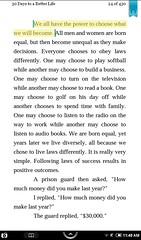The traditional mode of book publishing maps cleanly onto the dominant mode of theatrical performance of the last 19th century, one that has with some exceptions carried forth into the present day: a mode we could call Proscenium Realism. The proscenium first appeared in 1618 at the Farnese Theatre in Parma, Italy. However, it was not until the 19th century that it fully came into its own. It provided quite literally a frame for the performance as if it were a photograph, or an aperture through which the audience could peer into some actual “real” scene unfolding before their eyes. The Realist playwrights of the time wanted to create a sense that there was no artifice, that life as actually lived was occurring before the audience’s eyes—the proscenium enabled that. The more fantastical performances, including opera and ballet, could benefit from the picture window effect, that the audience was witnessing a complete and total illusion, that of a painting come to life.
In both cases, of course, there was an elaborate apparatus undergirding the entire performance. Actors running off-stage to get props, gas and then electric lights dimming as night falls, trees moving on and off, angels being lowered by winches, all carefully hidden by the walls and (when necessary) by the curtain closing and reopening to a new vista no less real than the one that preceded it.
Meanwhile, the world of publishing had been building a machine not dissimilar from the apparatus for producing the theatrical illusion. Theatre has its playwrights, yes, but also stage managers, lighting designers, scenic artists, actors, and composers, its lights, its rigging, its costumes, its sleight-of-hand around forced perspective, the clacking of coconut shells mimicking the clip-clop of horse’s hooves, and so forth. So too with publishing, though in that black box the machine was a manufacturing and distribution apparatus. As with the theatre there were wordsmiths yes, authors yes, at the beginning, but also agents to help frame and contextualize the authors for the editors, editors to evaluate the authors, but also to ensure the author’s writing fit style guides that wouldn’t trip up the ultimate consumer with anachronisms and inconsistencies, designers to create covers to serve partly as images to represent the book, in the manner of classical architecture, but also to help sell the book, like the tried-and-true maneuvers of the strip tease, showing a little of what’s there but suggesting that more, oh so much more is to come. Sales reps, whether the door-to-door snake oil peddlers of the 19th century selling subscriptions out of a bag, or the 20th century model of showing up at the retailers persuading them to stock that publisher’s inventory. Then too over the course of the second half of the century, all the innovations around distribution, often using computing power of the mainframe and PC variety—just-in-time inventory, demand forecasting, tighter product cycles, granular sales data.
And the writers and readers, opposite ends of the supply chain, in a strict producer-consumer relationship, stand at either end of the machine, marveling as its mysterious processes, selecting a handful of writers and magically transforming them into bestsellers, consigning readers to gape slack-jawed at its marvelous outputs, then rushing, after it was all over, the magical words THE END, read, to the stage door, where they hope to catch a glimpse of the creator before s/he is hustled to a waiting car.
In the theatre along comes Brecht and to rip down the curtain. While that is, and what is to follow is, a radical simplification of very complex processes, Brecht, for reasons combining the political and the aesthetic, proposed to blow up the entire architecture of illusion and realism, to show how things are actually made, to show why things were the way they were. Stage hands walked around, handed props to people, brandished the coconut shells, proudly ate the banana the peel of which would be dropped just in time for the actor to slip on it, actors changed costumes in full view, the lights turned around, no longer mimicking the dawn rising, instead turned onto the audience, now suddenly busted for being Peeping Toms. The means of production had been laid bare.
And to book publishing now enters the Internet, stage left, stage right, stage center. The fluorescent lights now turned on. Freelance cover designers now available as guns-for-hire since everyone has Photoshop now, agents trawling Wattpad for the popular writers, forums discussing royalty structures, kerning and leading. Short-run digital printing via Lulu, Lightning Source, Blurb, CreateSpace. Retail access via Amazon and Amazon and Amazon and Amazon. Tablets, phones, and E Ink devices rendering almost all the foregoing optional. The bride stripped bare by her bachelors, even. The world is now the stage.







